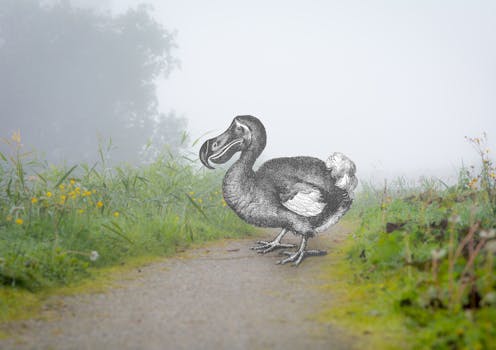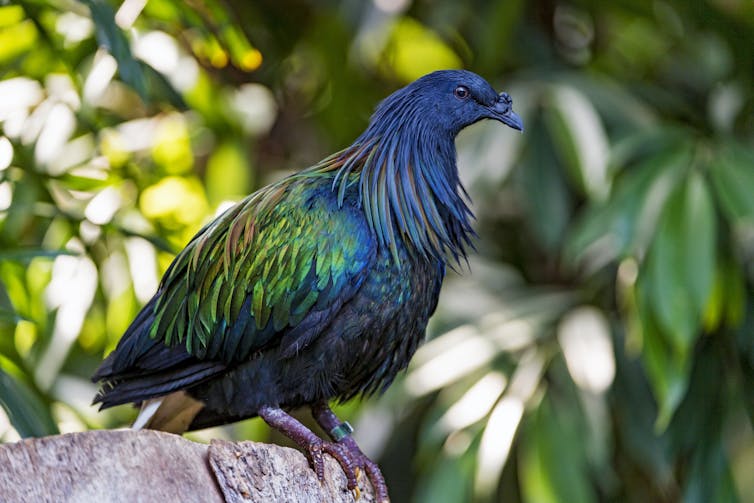
It’s no secret that human activities have put many of this planet’s inhabitants in danger. Extinctions are happening at a dramatically faster rate than they have over the past tens of millions of years. An estimated quarter of all species on Earth are at risk of being lost, many within decades.
What can scientists possibly do to stop that trend? For some, the answer is to “de-extinct.”
You can listen to more articles from The Conversation, narrated by Noa, here.
Colossal, a biotechnology company that garnered headlines for its plan to “de-extinct” the woolly mammoth, is now attempting to “bring back” the famously dead dodo bird. The company says its goal is to create a population of undead dodos to put on the Indian Ocean island of Mauritius, where the hefty, flightless creatures lived before humans drove them to extinction in the late 1600s.
As environmental humanists, we study the morality of different conservation interventions, and are interested in how de-extinction might change the ways people think about their responsibilities toward nature. One of us, Ben, is a professor of environmental ethics who explores the ethics of de-extinction in his 2018 book “The Fall of the Wild.” The other, Risa, is a doctoral student researching how de-extinction might change public perceptions about extinction, especially its emotional impact.
What de-extinction is and isn’t
De-extinction is not exactly what it sounds like. Rather than “bringing back” lost species, it’s more of a process to create their high-tech look-alikes.
Scientists would edit the genomes of the dodo’s closest living relative – the Nicobar pigeon, which contains the pigeon’s full set of DNA – and add some of the most important dodo genes, taken from preserved dodo remains. Then they could put that genome into an egg cell, and let that egg develop into an organism that should look like a dodo.
But that organism wouldn’t be genetically identical to the dodo. Nor would it have any other dodos to teach it how to act like and, well, actually be a dodo.

Colossal hasn’t successfully created any de-extinct creatures yet. Nor have any other scientists, unless you count the team that cloned the Pyrenean ibex in 2003 – but that clone died within minutes. And yet Colossal seems confident, saying it hopes to de-extinct Tasmanian tigers by 2025 and woolly mammoths by 2027. They’re certainly amassing a fortune to make it happen: Since its founding in 2021, Colossal has raised over US$225 million from tech investors, Paris Hilton and even a CIA-backed venture capital firm.
Possibilities, or pitfalls?
Supporters have argued that de-extinction will eventually help restore ecosystems. “Bringing back” passenger pigeons could help restore forests in the northeastern United States, for example, while woolly mammoth proxies could help restore the Siberian steppe and keep permafrost frozen. Some de-extinction advocates have also positioned their projects as potential long-term solutions to combating mass biodiversity loss in general.
But many ecologists and ethicists have highlighted the uncertainty around introducing these novel creatures into the wild. Even if the de-extinct dodos did act more or less like their extinct counterparts, it’s hard to know how a habitat that hasn’t had any dodolike birds in it for 350 years would be affected by this new species. Opponents have pushed back even more strongly against claims that de-extinction could be a widespread solution, pointing out how bringing back one species at a time would not be enough to curb the Earth’s losses.
Other issues include how to decide where all these de-extinct creatures would live, as well as animal welfare concerns: for potential surrogate animals that would be impregnated, and the de-extinct creatures themselves, which never asked to be “brought back.”
More than science
To us, one of the more interesting questions about de-extinction has to do with how it changes the way people think about extinction.
Some de-extinction boosters have argued that de-extinction could create a more hopeful story about humans’ ability to combat mass extinction. Many others share the desire for more inspiring conservation stories, too. Some conservationists and psychologists have argued that environmentalists need more positivity to get people engaged with environmental issues.

Others, however, say de-extinction isn’t hopeful, but misleading. Many worry that de-extinction actually risks making humans less inclined to care about ongoing extinctions. After all, why care about preventing extinction if we can eventually reverse it?
It’s hard to rally the troops with a message of unrelenting guilt and despair. But reckoning with those difficult emotions can be useful for reflecting on humanity’s responsibilities – especially considering that extinction is our fault to begin with, and since de-extinction isn’t really “resurrecting” anything.
In fact, some scholars argue that what humans really need is to learn to grieve extinct species. Grief, they say, is a transformational process that helps people recognize the value of what’s been lost and appreciate what’s left. Grief will never be enough without action. But we believe learning how to grieve together can be a more responsible and honest way to cope with extinction than pretending it can simply be undone.
So which is better at motivating care for the environment: positive or negative stories? There are still no sure answers, and testing their impact on audiences today is a key part of Risa’s research. Perhaps it can help conservationists at large learn how to tell more motivational stories – but it will take some time to get there.
In the meantime, we suggest that de-extinction scientists and advocates call de-extinction what it really is: not resurrecting extinct species, but creating their replacements.
Les auteurs ne travaillent pas, ne conseillent pas, ne possèdent pas de parts, ne reçoivent pas de fonds d'une organisation qui pourrait tirer profit de cet article, et n'ont déclaré aucune autre affiliation que leur organisme de recherche.
This article was originally published on The Conversation. Read the original article.







